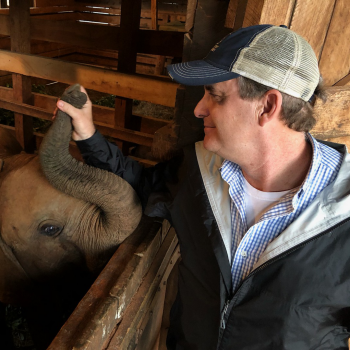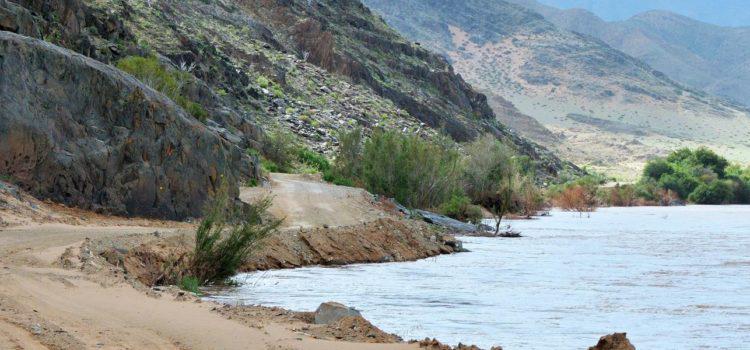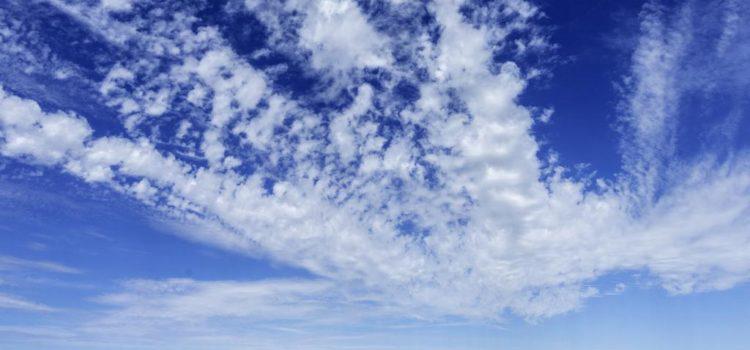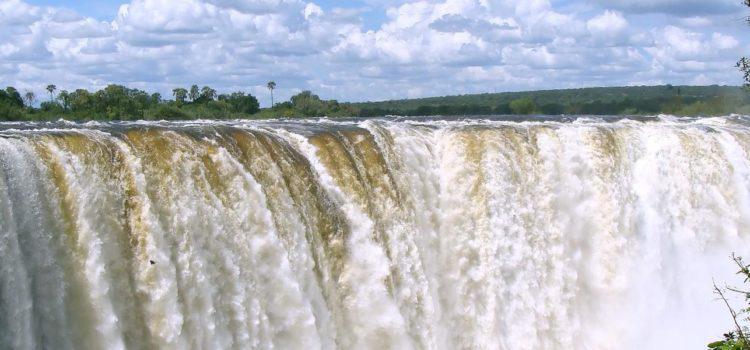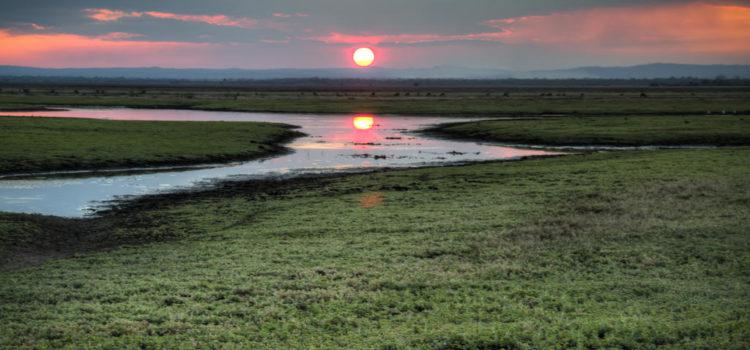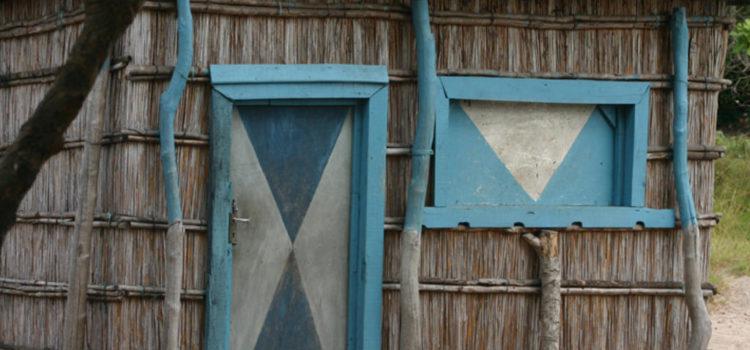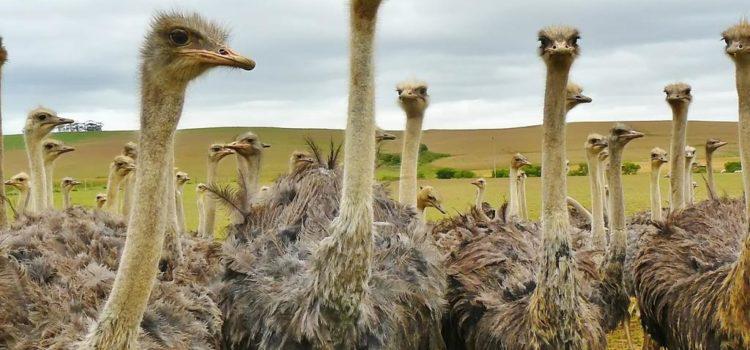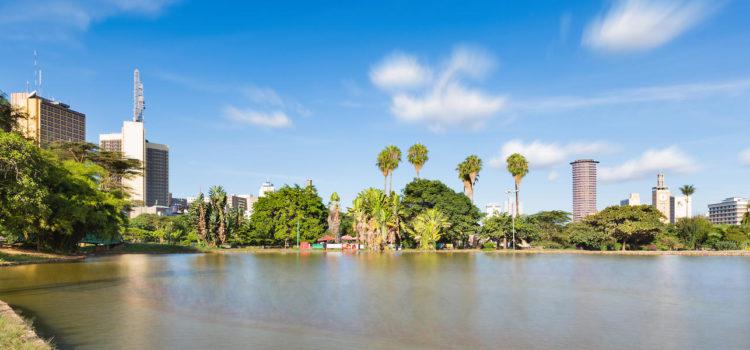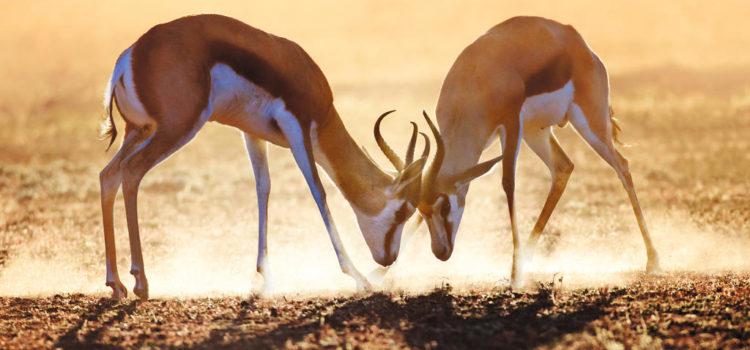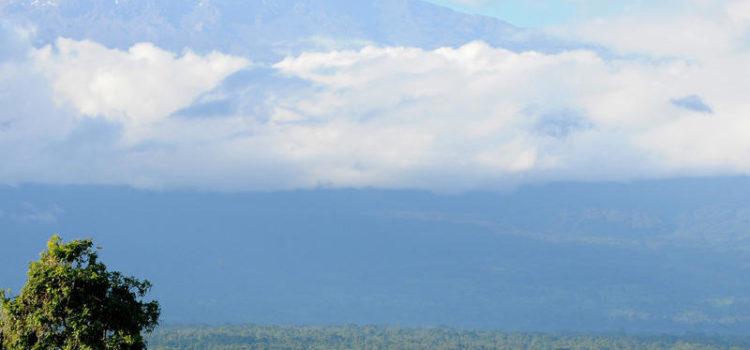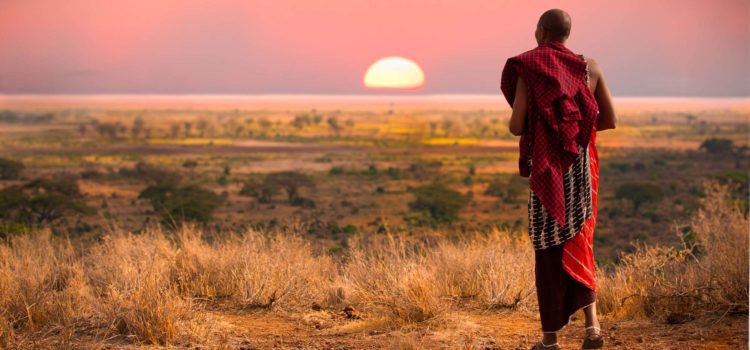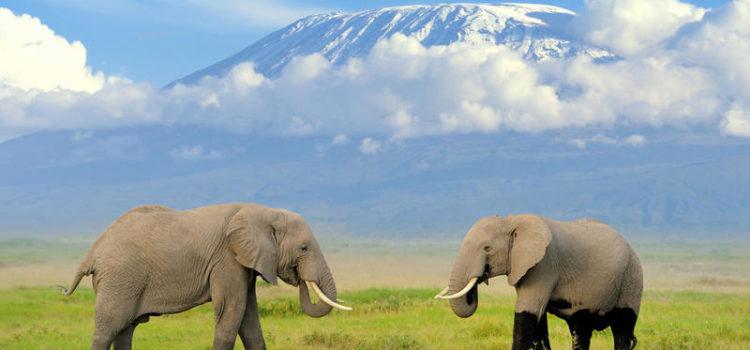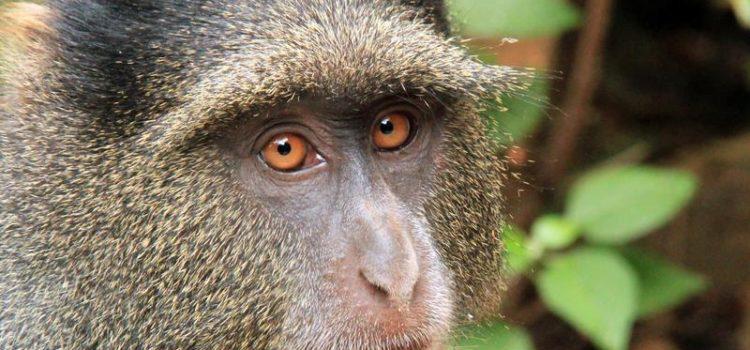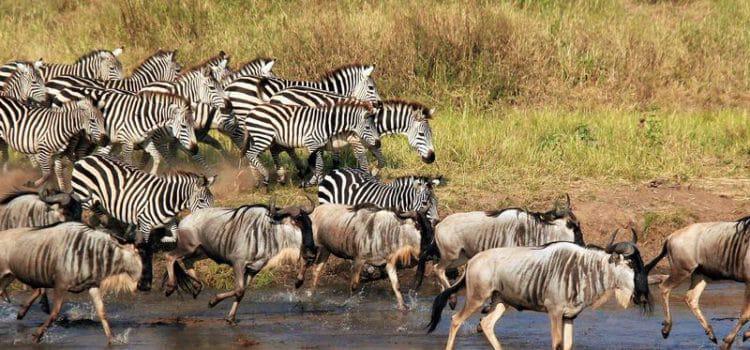Summary
Map
Full Day by Day Itinerary
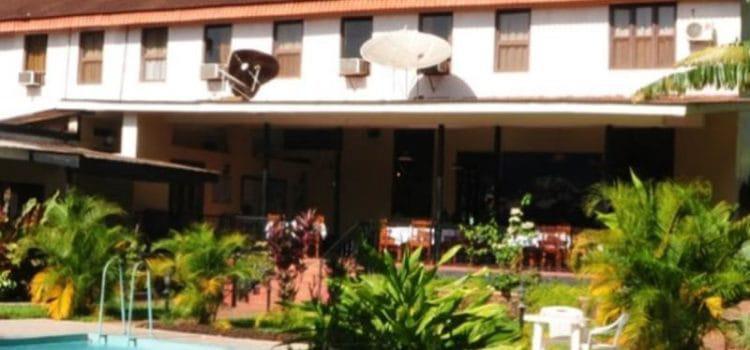
Day 1
You will be transferred from Kilimanjaro Airport to the Keys Hotel.
Situated south of the equator – in Tanzania – at 19,340 feet (5,895m), Mount Kilimanjaro is Africa's highest mountain and the highest "free standing" mountain in the world. Huge permanent glaciers flow down from the summit, and spectacular views and beautiful ice formations are the reward for the successful trekker, as well as the satisfaction of conquering this mighty peak.
It is not for the faint hearted – this will test you to your limits, mentally as well as physically. The main problems encountered are altitude sickness, which can be countered by use of medicines, and lack of oxygen. The standard route is a hike – no climbing as such. It is very cold – correct kit is a must – but our kit lists and hire equipment are top quality. We have personally done the major routes, so can offer first hand advice.
Good preparation and advice, as well as good guides on the mountain, have given us an over 95% success rate (the average is 60%) – this type of thing is a "once in a lifetime" challenge and must not be taken lightly. We ensure that all our climbers have all the facts – medical list, equipment list, etc – long before they travel and this is probably the reason for our high success rate.
Any reasonably fit person who enjoys walking can reach the summit of Kilimanjaro. The youngest to make it was nine years old and the oldest was seventy-nine.
Machame Route is one of the most scenic routes up the mountain. After Umbwe Route, this is probably the most beautiful route by which to ascend. Nights are spent in high-quality 3-man alpine tents sleeping a maximum of two persons per tent (so there is space for your luggage too).
All your supplies and camping equipment are portered up for you (tents, 20 – 25mm compressed foam sleeping mats, awnings, stools, lights, etc) and your meals are prepared. Your personal baggage limit is 25 lbs. for the climb.
The guides employed are excellent (some have climbed Kili over 400 times)! They are employed by the Keys Hotel, your base hotel, and have looked after a multitude of our clients. Each trip is led by a senior guide, with other guides in a ratio of approximately one guide per 2 or 3 climbers. If you are a bit slower than the rest or get ill and have to descend, a guide will always be with you.
Food served on the mountain is generally plain and wholesome, including a lot of carbohydrates, stews and soups, vegetables, and fresh fruit. Vegetarians are catered for, but please notify us in advance.
When flying, we strongly suggest you wear / carry on your boots, wet weather gear and cameras – these are crucial for your climb and you do not want to risk losing them in the hold. Make sure you have your yellow fever certificate with you – you will be asked to produce it on arrival in Tanzania (and, in some cases, you might need t show it on arrival back home as well).
Overnight Keys Hotel in Moshi with a full English breakfast.
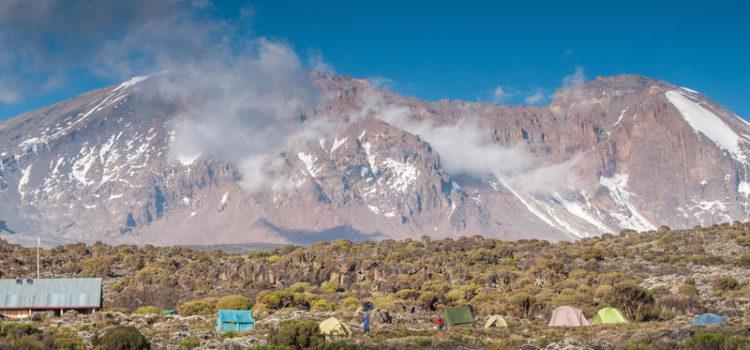
Day 2
After an early breakfast, a senior guide will do your climb briefing after which you will depart for the National Park Gate (approximately 1 hour), where you will meet your guide and porters. There is a lot that happens behind the scenes, e.g. porter loads being distributed, etc., so relax – it takes quite a bit of time. Sign into the National Park.
After the formalities at the gate have been completed, you will start your walk through the spectacular tropical rainforest, generally in the company of the assistant guides. The head guide will stay behind and sort out the balance of the arrangements and catch up with you later. The guides will stop at a designated spot for you to have your lunch pack that the hotel has provided. The entire day is spent in equatorial rainforest and you won't have good views of Kibo. Towards the end of the day, you will break out of the forest and arrive at Machame Hut (3,000m). This section of the climb should take you in the region of 5 hours to complete.
Wear your hiking boots today and ensure you keep your wet weather gear with you. Shorts and t-shirt should be sufficient. There are patches on the route where it is VERY wet and muddy, and you may end up with wet boots this evening. Ensure your boots are waterproofed and that you have spare lightweight (closed) shoes to wear in camp this evening. Gaiters are also advised to help you keep the mud and dampness out.
Take it SLOWLY today – your climb is made in the first two days so you need to get a slow, steady pace going. You will encounter some steep parts on the climb, but generally it is not too strenuous. The porters walk ahead so make sure, every day, that you have all your personal gear needed with you in your daypack as you will not have access to the bag that the porter will be carrying.
The porters will set up camp and the crew will prepare your meals. Conditions are difficult on this route and your guide and the rest of the crew will do everything they can to make your climb pleasant and as comfortable as possible. Eat well – at higher levels your appetite will diminish.
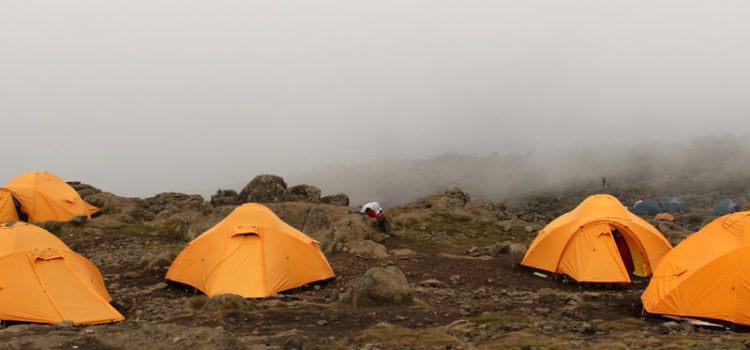
Day 3
Ascend to Shira Hut at 3,800m. When you depart from Machame Hut, you will be in the heather zone and you will be climbing up one of the ridges on the mountain. It is a fairly steep start, followed by an hour or so of hard uphill, then 2 hours at a gentler angle through the lower moorland, which brings you to the top of a rocky bluff. Lunch is normally taken here.
From the lunch stop, you will start traversing westwards up towards Shira Cathedral. The last sections of this route are relatively flat and easy but, once again, take it very slowly.
Take a jersey with you today as it cools down considerably during and after lunch. Again, keep your wet weather gear handy and some snacks for the route. Drink plenty of water – it is vitally important to keep your fluid intake high as it aids the acclimatisation process.
Camp at Shira – it's a pretty exposed and cold campsite and you may get rain or sleet. In the morning, the ground and tents could be frozen over. You do, however, get to see some of the most spectacular sunrises and sunsets as your reward for camping here!
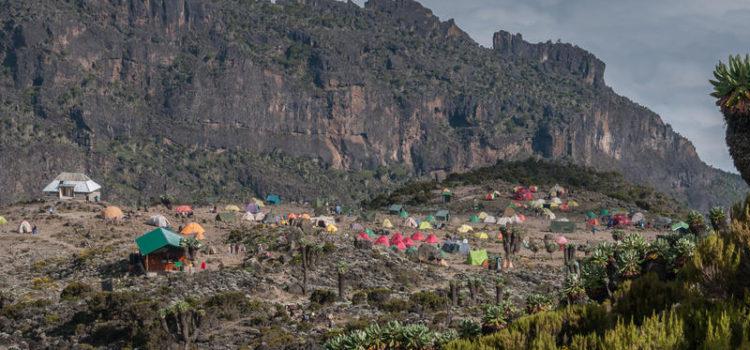
Day 4
From Shira, you will set off to Barranco (3,900m), skirting just below Lava Tower. You are now walking at an approximate altitude of 4,500m while traversing around the southern side of the mountain. A few steep sections of uphill and valleys, some parts that look like a "moon landscape", and quite a steep descent to Barranco – it's a long and fairly tiring day.
This is part of your acclimatisation – walking in height from 3,800m up to 4,500m and then overnighting at 3,900m. Once again, pace yourself to gain altitude slowly. The night temperature at camp could be cold (night frosts).
The views of the glaciers on Kibo are breathtaking from camp and, when you turn around, you have the most beautiful Umbwe Valley below you – one of the most scenic campsites on the mountain.
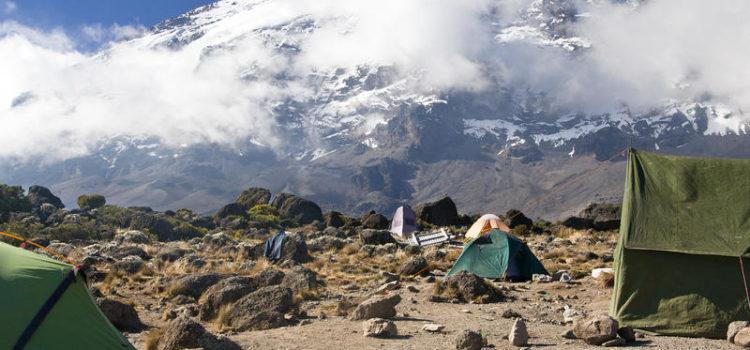
Day 5
Continue from Barranco, across and up towards Karangu Valley (3,900m). The first obstacle this morning is the Barranco (Breach) Wall – it's a climb over rock and it looks like a sheer rock face, but it is a hike and there is no technical climb involved. It is a rather tiring, hard and long day though and the guides might use rope on some sections for peace of mind. There's a steep descent down into Karanga Valley, with a short, steep ascent out of the valley to the campsite on the other side of the valley where you will camp tonight. You should arrive around lunchtime.
Learn to pace yourself with your breathing – do not try to rush to catch up with anyone, go at your own most comfortable speed and you will arrive relatively comfortably. Listen to your guide(s) – they will help you. It will be very cold today, especially when you stop for lunch and rest. Dress warmly as you can expect some sleet on this day. You will be walking through the cloud.
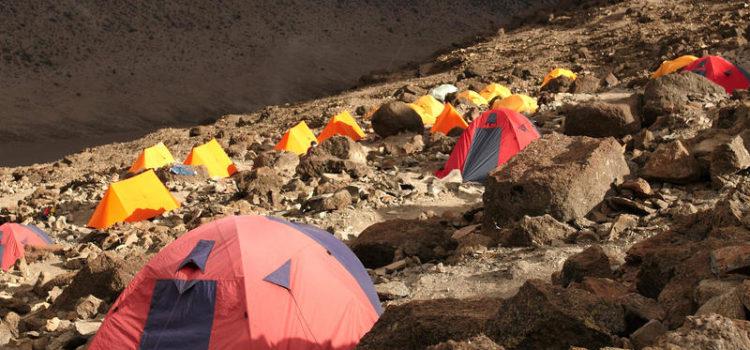
Day 6
From Karangu Valley, you'll continue the climb to Barafu, from where you will start your final ascent to the peak tonight. Along the way, there is a lot of shale rock – some of it paper thin! You'll have great views of Kibo along the way, if the weather is clear. You should arrive around lunchtime, which gives you a good few hours to rest before the midnight ascent.
After supper, drink as much fluids as possible and settle down for an early night. Drink plenty of fluids as you are in a "desert" area, despite the cold, and tomorrow will be a long, hard day.
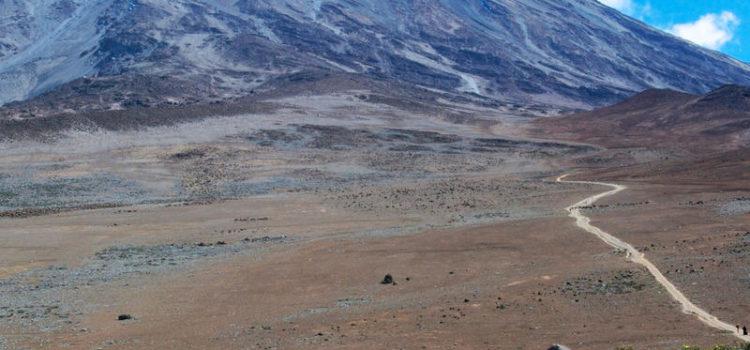
Day 7
Today is a very long and strenuous day. Drink lots of fluid before you start – you will be very thirsty by the end of it. If you can manage, carry 3 litres of fluid with you.
You will be woken at about 23:00 or 00:00 with tea and biscuits. Put on all your clothing, ready for the final ascent.
You will be climbing up scree for approximately 4 – 5 hours. The guide(s) will stop frequently to rest and check on the group. It is very important to listen to your body and breathing, and try to get into a rhythm. Because of the slowness of your walk, your fingers and toes are likely to get extremely cold. Three pairs of socks should be considered for today and two pairs of gloves (inner and warm outer). The views from the mountain (on the way up) are spectacular – you gain incredible height over a short distance.
You arrive at Stella Point (5,750m) on the crater rim and have a quick rest the sun should be shining! From here, continue around the crater rim to Uhuru Peak (5,895m), the highest point in Africa.
After taking pictures and enjoying the view, you descend along the crater rim to Stella Point, from where you descend further to Barafu. You will travel down quickly on the scree, gasping in more oxygen step by step. The porters do not travel to the summit with you and the tents stay up at camp so, depending on the timing of your summit, you will be able to have some rest here (maybe a short sleep) and something to eat. After a good rest and some nourishment, you can pack your outer clothing items in the bag the porter carries before you continue down the Mweka Route.
This is a long descent, and Mweka always seems to be on the "next hill", never arriving. Arrive at Mweka (3,100m), on the edge of the rainforest, in the late afternoon for overnight camping. You will have time to reflect on the day's achievement.
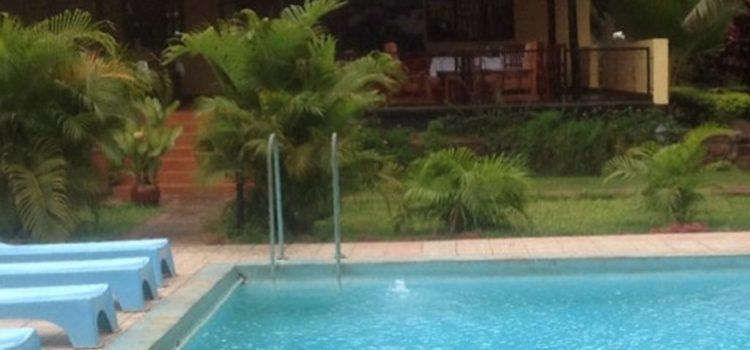
Day 8
It is a 3 – 4 hour descent through the pretty rainforest to the Park Gate at Mweka where the vehicle will meet you. There are generally beers and Cokes for sale at the park gate. You will then be transferred by vehicle to the hotel (approximately 45 minutes' drive), ready for an evening of celebration.
Your certificates are generally handed out by the guides (either at the gate or, on occasion, they may join you at the hotel).
Overnight at Keys Hotel with full English breakfast included.
Liaise with your head guide regarding tips – we recommend approximately US$200 – US$230 per climber for the 7-day climb, which the guide will apportion out amongst the group. Whilst the above figure is "expected", anything above that is totally at your discretion.
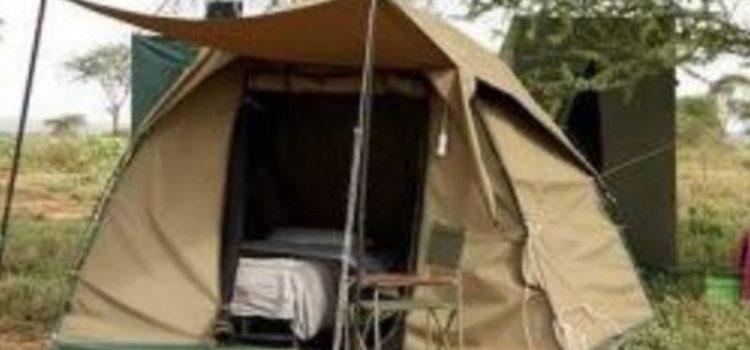
Day 9
Our Adventure Grade camping safaris are designed for those who really enjoy camping, but prefer to travel in small groups.
We use small vehicles (5 – 7 seaters) and carry all the equipment with us, usually in a trailer. A safari driver / guide and cook travel with the group and guests are expected to assist with putting up and dismantling the camp. Public campsites are usually used.
Staff
Services of a professionally trained driver / guide, safari chef, and camp assistants (two or more, depending on the size of the group).
Vehicles
Transport in custom-built 4×4 safari vehicles, generally land cruisers, with maximum 5 – 7 passengers with guaranteed window seats per vehicle, equipped with game viewing hatches in the roof. A trailer may be used for excess camping gear, allowing more room in the vehicle.
Equipment Provided
Insect-proof, spacious walk-in tents (3m wide x 1.9m high x 3m long), mess / dining tent with table and chairs for meal times, fridge and / or coolbox, and all cutlery, crockery, glassware, tablecloths, etc.
During your private tailor made safari, you will be accommodated in or near the parks as described below. The days will be spent giving you the best game viewing experience possible in each park, with either morning and afternoon game drives, or full day excursions. If you are opting to do a "drive-in" safari, the drives between parks may be broken with cultural visits to local villages, or historical hotspots and further game viewing, guaranteeing that your transfers are far from boring. Your itinerary is fairly flexible from day to day and options may be discussed with your guide before setting off for the day.
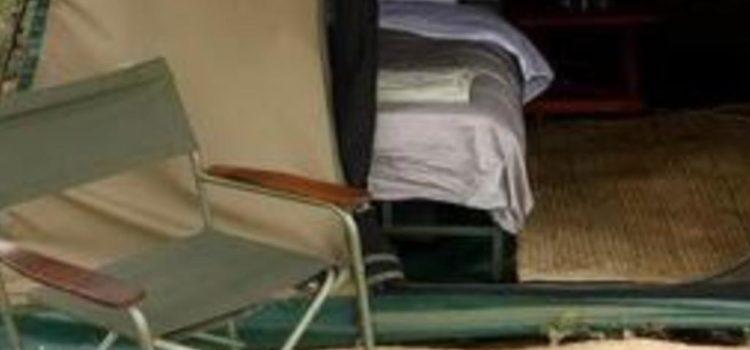
Day 10
Lake Manyara National Park is famous for its tree climbing lions, who spend most of the day spread out along the branches of Acacia trees six to seven meters above the ground. Nestled at the base of the Great Rift Valley escarpment, the park is noted for its incredible beauty. As visitors enter the gate, they pass into the lush forest, home to troops of baboons and both blue and vervet monkeys. Further along, the forest opens up into woodlands, grassland, swamps and beyond the soda lake itself, covering 200 square kilometers and sanctuary to over 400 species of bird including flamingo, pelican, stork, sacred ibis, cormorant and Egyptian Geese. The park is particularly noted for its huge herds of buffalo and elephant, as well as giraffe, hippo, reedbuck, warthog, wildebeest, zebra and a great variety of smaller animals.
The Adventure Grade camping safari offers a host of benefits for a unique bush experience:
• You awake to the chatter of birds in the morning and go to sleep with the sound of distant lions – no noisy lodges
• Top quality equipment is used, including tables for dining, chairs, mess tent, etc.
• Guests are provided with a safari bed roll comprising of comfortable mattress, sleeping bag, liner, and small pillow.
• All meals are prepared by our safari chef.
• The National Park public campsites we use are all located in good parts of the park.
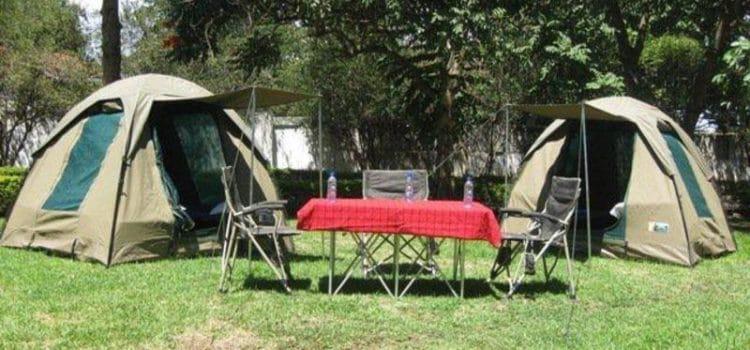
Day 11
Depart after breakfast and drive to the Ngorongoro Crater where you will spend the rest of the day game viewing including picnic lunch.
Head down into the Ngorongoro Caldera below and spend the rest of the day enjoying game viewing in one of the most spectacular places on earth! Photographic opportunities are abundant, and one often sees four of the Big Five in a short time. Have a picnic lunch at the floor of the crater at a pleasant lakeside location where you can stretch your legs and soak up the magnificent scenery.
The Ngorongoro Crater, at 2,286 meters above sea level, is the largest unbroken caldera in the world. Surrounded by very steep walls rising 610 meters from the crater floor, this natural amphitheatre measures 19.2 kilometres in diameter and 304²km in area. It is home to up to 30,000 animals, almost half of which are wildebeest and zebra. Buffalo, elephant, hippo, hyena, jackal, lion, ostrich, serval, warthog, bushbuck, eland, hartebeest, reedbuck, waterbuck and huge herds of both Thomson’s and Grant’s gazelle are easily seen on the crater floor.
Thanks to anti poaching patrols, the crater is now one of the few places in East Africa where visitors can be certain of seeing black rhino, with the number now approaching 25. Leopard may occasionally be seen in the trees of the forest surrounding the crater, while cheetah are also present. Countless flamingo form a pink blanket over the soda lakes, while more than 100 species of birds not found in the Serengeti have been spotted. The crater, having been declared a UNESCO World Heritage Site, lies within the Ngorongoro Conservation Area, which covers more than 8,300²km.
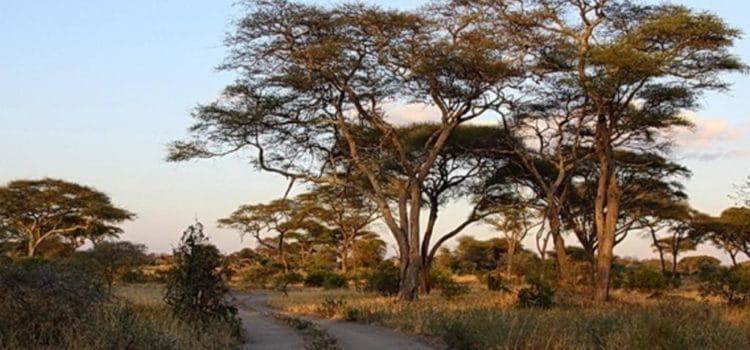
Day 12
Tarangire National Park is the sixth largest national park in Tanzania, it is located in the Manyara Region. The name of the park originates from the Tarangire River that crosses the park. The Tarangire River is the primary source of fresh water for wild animals in the Tarangire Ecosystem during the annual dry season. The Tarangire Ecosystem is defined by the long distance migration of wildebeest and zebras. During the dry season thousands of animals concentrate in Tarangire National Park from the surrounding wet season dispersal and calving areas.
It covers an area of approximately 2,850 square kilometers (1,100 square miles.) The landscape is composed of granitic ridges, river valley, and swamps. Vegetation is a mix of Acacia woodland, seasonally flooded grassland, and Baobab trees.
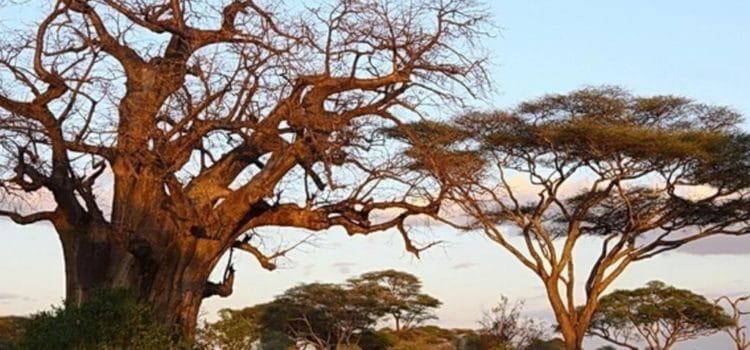
Day 13
The park is famous for its high density of elephants and baobab trees. Visitors to the park in the June to November dry season can expect to see large herds of thousands of zebra, wildebeest and cape buffalo. Other common resident animals include waterbuck, giraffe, dik dik, impala, eland, Grant's gazelle, vervet monkey, banded mongoose, and olive baboon. Predators in Tarangire include African lion, leopard, cheetah, caracal, honey badger, and African wild dog.
Home to more than 550 bird species, the park is a haven for bird enthusiasts.
The park is also famous for the termite mounds that dot the landscape. Those that have been abandoned are often home to dwarf mongoose.
In 2015, a giraffe that is white due to leucism was spotted in the park. Current wildlife research projects in the park include the Tarangire Elephant Project, Tarangire Lion Project, and Masai Giraffe Conservation Demography Project.
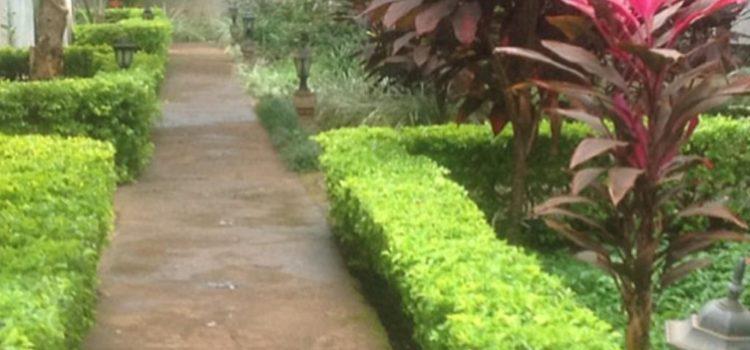
Day 14
Following breakfast and a game drive you will be driven back to Moshi where you wil spend your last night on this trip.
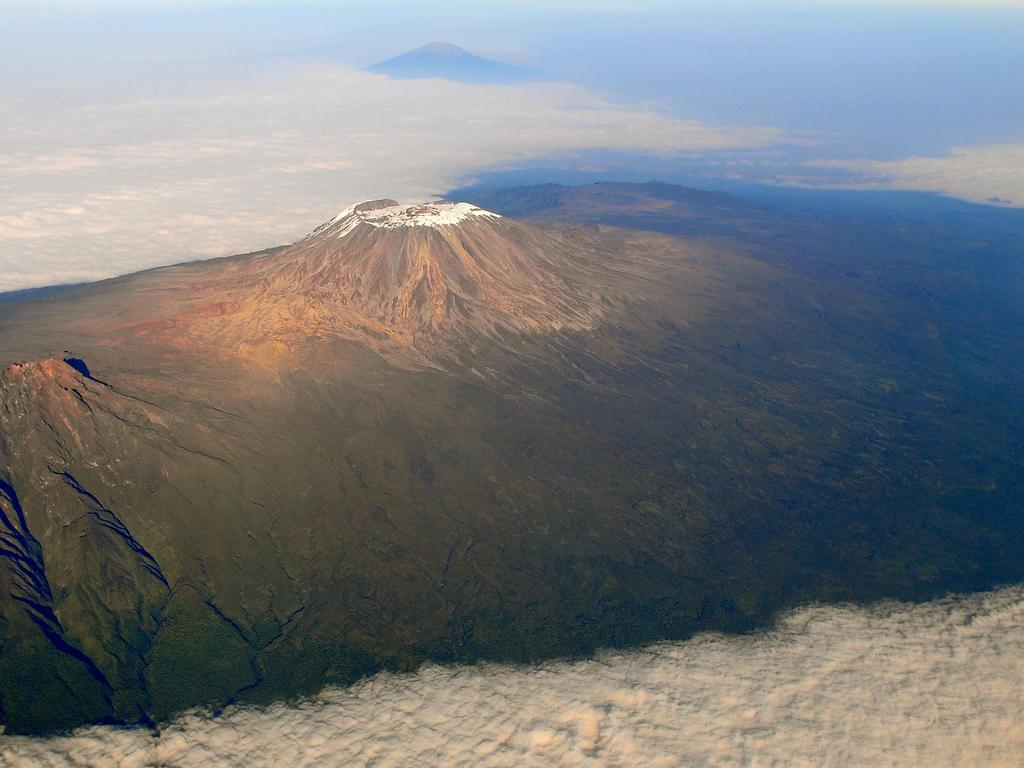
Day 15
You will be driven to your international flight departing from the Arusha Airport. The fight will head to Amsterdam where you will then connect with your US based flight the next day.
Included / Not Included
Included
Accommodation as per schedule
Meals as indicated
Game Park Fees
Activities as indicated
Services of guide with vehicle, fuel & taxes
Not Included
Visas – Tanzania Single entry
Meals not indicated
Activities not Indicated
Drinks, Gratuities, Personal Spending

